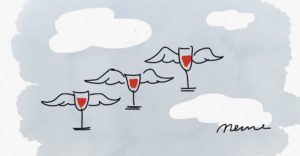 Why is a set of wines arranged in a particular order for tasting purposes referred to as a flight? Even the venerable Oxford English Dictionary doesn’t seem to know. Its editors don’t give an example of the word used in this way. In wondering about the use of the term in this context, it’s natural to think of things that take to the skies — like birds, balloons, or home runs.
But we’d be closer to the truth, I think, if we added to the notion of ascent the idea of ordered array.
Why is a set of wines arranged in a particular order for tasting purposes referred to as a flight? Even the venerable Oxford English Dictionary doesn’t seem to know. Its editors don’t give an example of the word used in this way. In wondering about the use of the term in this context, it’s natural to think of things that take to the skies — like birds, balloons, or home runs.
But we’d be closer to the truth, I think, if we added to the notion of ascent the idea of ordered array.
Consider, for example, a wedge of wild geese winging south for the winter, or a precision military flying team like the Blue Angels. Or, the term’s nearest relation may have naught at all to do with winged things. It may instead recall nothing more picturesque than a flight of stairs. In fact, a staircase is a near perfect analogue for an artfully constructed flight, in which each wine follows the previous one in a way that moves the taster’s experience along by measured steps, wherein some kind of progress is apparent.
One way in which they differ, I suppose, is that a flight of stairs has a definite and fixed destination, whereas with wine it really is the journey that’s the point. Unlike stairs, which are always identical to each other, a flight of wine aims at underscoring and highlighting difference, and how progressive shadings of flavor, texture, and scale affect the impression made by one glass upon another.
To create a flight, you might order wines from white to red, lighter to richer, simpler to more complex. That’s the conventional wisdom anyway. In practice, it can take a bit of experimenting to hit on a sequence that results in each wine being positioned to show its best. There’s not necessarily any right way to do it.
Pre-pandemic, when we were tasting and talking wine with our clientèle in the wine corner every week, job one in setting up the event was always determining the order of pour. There wasn’t always agreement, and there were plenty of times when we saw fit to change make a course correction. But the exercise made more attentive, more diligent, more competent tasters of us all, professionals and amateurs alike.
And it will do the same for you.